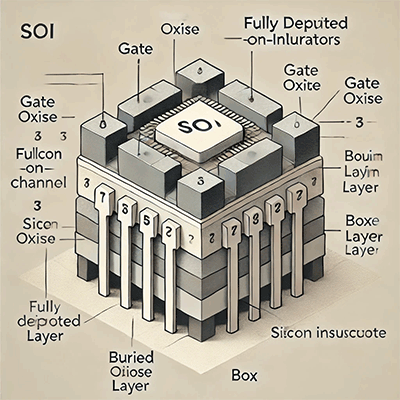Fully Depleted SOI Transistor
A Ph.D. Candidate requested a quote for the following.
I am trying to make a fully-
depleted SOI transistor structure by utilizing the buried layer oxide bottom gate, therefore I need a degenerate-doped substrate and thin oxide layer(<300nm).
Moreover, I need the device thickness to be as thin as possible. Since I am totally not the expert in SOI process, could you give me more information in term of the process limits and my idea feasibility.
Reference #180855 for specs and pricing.
Get Your Quote FAST! Or, Buy Online and Start Researching Today!
How Do you Make A SOI Transistor?
Fully Depleted SOI Transistor Diagram - Reference Labels:
1. Gate - The control electrode for modulating the transistor's channel conductivity.
2. Gate Oxide - Thin insulating layer under the gate that isolates it from the silicon channel.
3. Channel (Fully Depleted) - The area between the source and drain where current flows when activated.
4. Source - Terminal from which charge carriers (electrons or holes) enter the transistor.
5. Drain - Terminal to which charge carriers exit the transistor.
6. Silicon Film - The thin silicon layer on top of the BOX layer where the channel is formed.
7. BOX (Buried Oxide) Layer - Insulating layer beneath the silicon film, isolating it from the silicon substrate.
8. Silicon Substrate - The bulk silicon layer beneath the BOX that provides mechanical support.
Each of these numbered labels corresponds to the same parts in the transistor diagram.
What Is Fully Depleted SOI Transistor Used For?
A Fully Depleted Silicon-On-Insulator (FD-SOI) transistor is used in various applications that require high performance, low power consumption, and excellent control over short-channel effects. Here are some common applications:
-
Low-Power Devices: FD-SOI technology is often used in mobile devices, IoT (Internet of Things) devices, and wearables, where power efficiency is crucial. FD-SOI transistors operate at lower voltages with reduced leakage, extending battery life in portable electronics.
-
High-Performance Computing: Due to its fast-switching capabilities, FD-SOI is used in processors that require both high speed and low power, such as CPUs and GPUs in data centers and servers. The high mobility in these transistors enables quicker data processing.
-
Automotive and Aerospace: FD-SOI is well-suited for automotive and aerospace applications, particularly in harsh environments. It provides radiation tolerance, making it robust against cosmic rays and other forms of radiation that can affect traditional CMOS transistors.
-
5G and Communication Systems: The low power and high-speed properties of FD-SOI transistors make them ideal for 5G infrastructure and other high-frequency communication applications, where speed and power efficiency are essential.
-
Analog and Mixed-Signal Circuits: FD-SOI technology is also beneficial in analog and mixed-signal circuits, as it provides good control over threshold voltages and reduced noise, improving signal fidelity in applications like ADCs (analog-to-digital converters) and DACs (digital-to-analog converters).
FD-SOI technology offers advantages in applications where a balance of performance, energy efficiency, and resilience to environmental factors are required.
How to Integrate A Photodiode With A Fully Deleted SOI Transistor
An engineer at a small tech company fabricating novel photodiodes requested a quote for the following.
We are working on a new imaging technology and would like 2 quotes.
- To date we are using silicon wafers with highly doped (10-18) epitaxial layers ranging in depth from 200 nm to 600 nm. For now we are flexible on the base wafer specifics, as in initial testing it only serves as a support. Similarly the thickness of the buried oxide is not critical, thicker would perhaps be easier to work with.
- We are interested in integrating our novel photodiode with a fully deleted SOI transistor and would be interested in quotes for the SOITEC SmartCut wafers with ~ BOX of 25 nm.
Ideally, the top silicon thickness would be between 600-1500 nm (I am not clear which thickness are available. I am also wondering if you sell double BOX wafers with the second BOX used as a stopping layer. Initially wafers would be for R&D versus production so lower volumes with variety could work, so for example 25-50 wafers and the smallest diameters available.
Reference #266339 for specs and pricing.
Fully Depleted SOI Transistor Diagram - Reference Labels:

- Gate - The control electrode for modulating the transistor's channel conductivity.
- Gate Oxide - Thin insulating layer under the gate that isolates it from the silicon channel.
- Channel (Fully Depleted) - The area between the source and drain where current flows when activated.
- Source - Terminal from which charge carriers (electrons or holes) enter the transistor.
- Drain - Terminal to which charge carriers exit the transistor.
- Silicon Film- The thin silicon layer on top of the BOX layer where the channel is formed.
- BOX (Buried Oxide) Layer - Insulating layer beneath the silicon film, isolating it from the silicon substrate.
- Silicon Substrate - The bulk silicon layer beneath the BOX that provides mechanical support.
Each of these numbered labels corresponds to the same parts in the transistor diagram.

